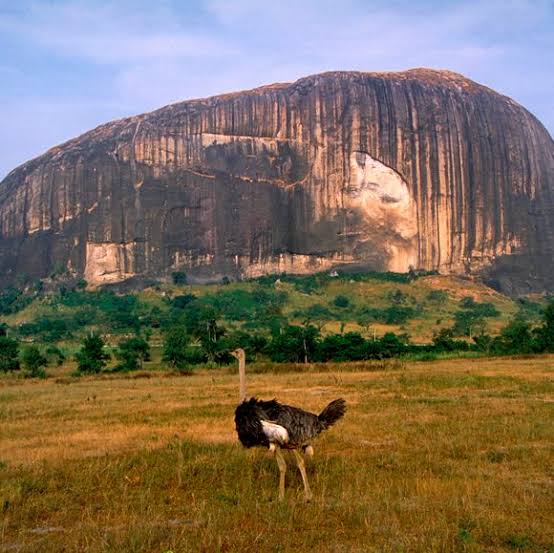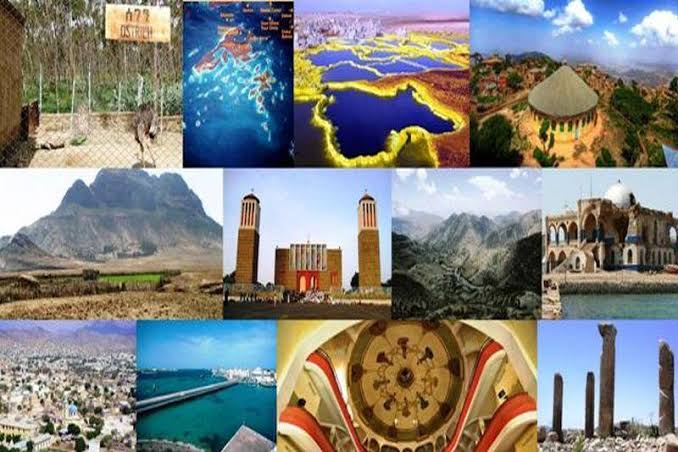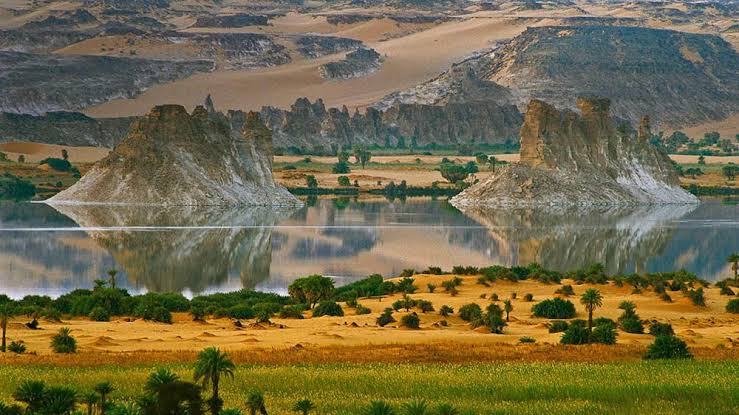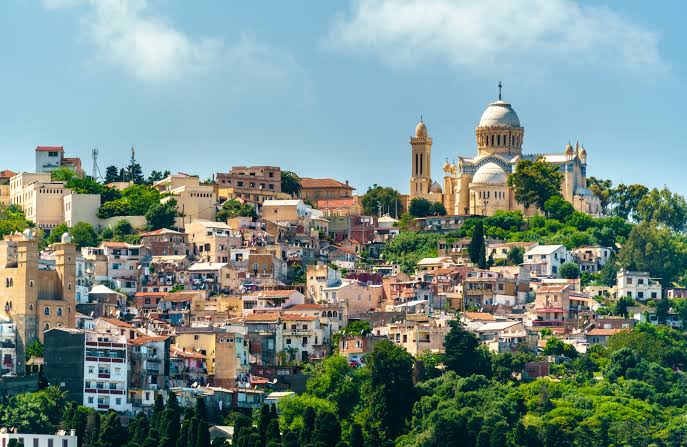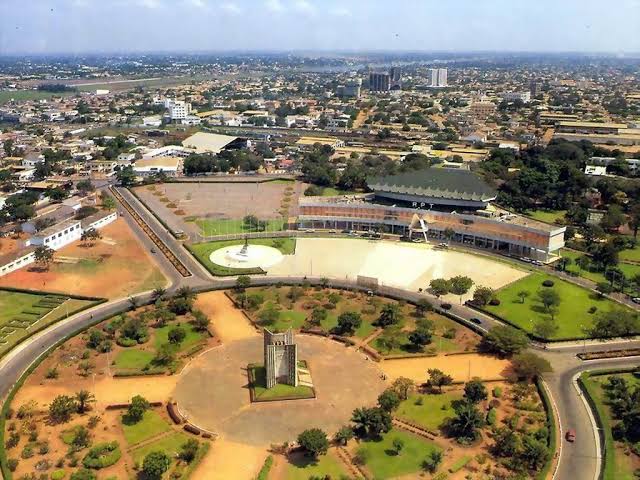Nigeria’s most elevated terrain consists of hills and spires that soar to great heights relative to the surrounding environment and the sea. At an elevation of 2,379 feet, Zuma Rock is the tallest feature on land.
Conversely, the Shere Hills, situated in Jos, Nigeria, are the highest hills. At 1,829 meters (6,001 feet) in height, it is more than double the size of Zuma Rock.
Furthermore, situated in Taraba State, Chappal Waddi Mountain is the highest point in Nigeria. These hills and mountains are distinguished by various attributes and, in certain instances, hold spiritual and historical importance for the local populace.
Despite this, the locations where these peaks and elevations are situated are extremely popular tourist destinations. Thus, both domestic and international visitors frequent these hills and rocky formations, which are also frequently traversed by hikers.
Which rock is the tallest in Nigeria?
1. Zuma Rock
- The height of Zuma Rock is 725 meters (2,379 feet).
- Location: Niger State
The beauty of the highest point in Nigeria, Zuma Rock, has garnered it a place on the country’s 100 Naira banknote. The enormous boulder measures 2,379 feet in height, which is approximately 1,859 feet greater than the NECOM House in Lagos, the tallest structure in Nigeria.
Popular belief holds that the location of the Zuma Rock is in Abuja, the Nigerian capital. Madalla, a village situated in Suleja local government of Niger State, the most expansive state in Nigeria in terms of land area, is its actual location.
The proximity of Madalla to Abuja is the primary reason why the boulder is presumed to be in the FCT. Nevertheless, it is visible throughout the city and is regarded as the gateway to Abuja. It is situated along the thoroughfare along Kaduna, Abuja.
In addition to its aesthetic appeal and apparent singularity, the rock possesses historical and spiritual significance.
From a historical perspective, the Zuba people of Niger discovered the rock in the 15th century; it was formerly referred to as Zumwa before being renamed Zuma.
During the conflict, it functioned as a sanctuary and defensive edifice for the Gbagyi people.
On a spiritual level, it is postulated to possess certain abilities, and contemporary reports suggest that it has been employed by criminals and ritualists. There are historical accounts that suggest malevolent entities reside within the bowels of the rock.
The rock potentially provided physical evidence in support of the Gbagyi people’s assertions, as it bears the features of a human visage, including the mouth, nose, and eyes.
They believe that this feature symbolizes ancestral forces that regulate the community and the face of a deity.
From a geographical standpoint, this facial representation emerges from the natural discharge that descends the stone from the summit of the igneous formation.
Mythologically speaking, Zuma Rock serves as an entrance to the afterlife. Consequently, in the present, it serves as a barrier against a catastrophic eruption; this is due to the assertion that a vast expanse of water lies beneath the rock.
An additional intriguing phenomenon that appears to be a myth but has been repeatedly validated is that the rock can occasionally emit fire. This initially garnered media attention in 2017, when a number of news agencies and social media platforms were enthralled by the report.
Nevertheless, it has been verified that the fire transpires annually in the course of the monsoon season. Although the populace may ascribe a spiritual explanation to the occurrence, a geologist has also speculated that it may be the result of volcanic activity. Should its volcanism be confirmed, it will join the numerous volcanic phenomena that occur in Nigeria.
Plateau State is where dormant volcanoes are located. Approximately 22 inert volcanoes are erupting in the state, according to studies.
2. Aso Rock
- Height: 400 meters (1,300 feet)
- Location: FCT Abuja
The Aso Rock is widely acclaimed and well-liked in Nigeria due to its unique geographical positioning within the Federal Capital Territory. At a height of 1,300 feet (400 meters), the Aso Rock towers over the sea at a height of 936 meters (3,071 feet).
Its location is on the periphery of Abuja. Furthermore, it is among the most conspicuous creations of nature within the Federal Capital Territory.
The Nigerian presidential villa, the Nigerian National Assembly, and the Nigerian Supreme Court are located in close proximity.
Like Zuma Rock, the Aso Rock region is predominantly populated by the Gbagyi ethnic group. As a result, the name Aso, which signifies triumph or success, originates from the tribe.
The granite holds a significant historical position within the Gbagyi community. In addition to historical accounts suggesting its utilization for divine worship, it was also employed during periods of conflict, aiding the populace in securing victory in numerous battles.
3. Wase Rock
- Height of Wase Rock: 298 meters (978 feet)
- Location: Local Government Area, Plateau State, Nigeria.
Wase LGA, Plateau State, is the location of Wase Rock. It is the natural marvel that has bestowed upon Plateau State the name”Home of Peace and Tourism.”
The rock, which stands at an elevation of 543 meters (1,781 feet) above sea level and 298 meters (978 feet) above the surface, is named after the local government in which it is discovered.
The boulder is visible from a distance of up to 40 kilometers due to its elevation. Its attributes consist of a pointed cleavage at its apex and a surrounding expanse of scree, which comprises fragmented rocks.
The Wase Rock is readily distinguishable due to its enormous dimensions and characteristic dome-shaped stony inselberg (Island Mountain) form.
An additional intriguing aspect of this rock is that it is one of only two specimens of its kind to be discovered in Africa, out of a total of five discovered globally.
An additional noteworthy characteristic of the rock is its function as a breeding site for the exceedingly uncommon Rossy White Pelican. It is recognized as one of the five exclusive habitats in Africa that supports the Rossy White Pelican.
4. Riyom Rock
- 250 meters (820.21 feet) in height
- Location: Plateau State
Riyom Rock obtained its appellation from the setting in which it originated. Riyom LGA, situated in North Central Nigeria, is approximately 25 kilometers from Jos, the capital of Plateau State.
Eldest among the tallest formations in Nigeria, it attains an impressive height of 250 meters (820.21 feet).
Riyom Rock, similar to the other mountains in Nigeria, possesses a distinctive and subtle characteristic that draws individuals in addition to its remarkable stature and structure.
Beta Betat is the name given to the rock by the Berom people of Riyom, who are Berom native speakers. The term refers to what appears to be three rocks piled upon one another. Unexpectedly, this mound of rocks diminishes in height as it ascends from a monstrous root.
Despite the apparent instability of the final and smallest rock, the peculiar rock formation has undergone the test of time.
Additionally, the rock has been dubbed “rocks placed by an unseen hand.” Indeed, the rock serves as a symbolic favor to the inhabitants of the community in which it is physically located.
5. Olumo Rock
- The height of Olumo Rock is 137 meters. 449 feet
- Location: Ikija Abeokuta North, Ogun State
The highest mountain in the southwestern region of Nigeria is Olumo mountain. At 137 meters (449 feet) above sea level, it is situated. Ikija is situated in the Abeokuta North region of Ogun State.
Olumo Rock, alternatively referred to as the Fortress of Abeokuta, is a formation of granite in Nigeria that has a rich historical background. The appellation was fashioned from the Yoruba word Olumo, which signifies “Mo” means “Moulded” and “Olu” means “God.” Throughout history, rocks have served as refuges and concealment during periods of communal unrest.
Throughout numerous years, the Egba people of Ogun State sought refuge at Olumo Rock amidst inter-tribal conflicts that transpired in the 19th century.
Since its designation as a tourist destination in 1976, the rock and its environs underwent a commissioning and remodeling process in 2006 with the intention of transforming them into one of the primary tourist attractions in Abeokuta. Olumo Rock is now equipped with constructed stairs and an elevator to alleviate the anxiety of climbers.
In addition to the aforementioned establishments, the attraction center of Olumo Rock encompasses a water fountain, a museum, and an Itoku market where souvenirs and other tourist necessities are for sale.
Prominent Abeokuta landmarks visible from Olumo Rock include the First Church in Nigeria, the Abeokuta Central Mosque, and the River Ogun.
6. Gibadi Rock
- An estimated height of 100 meters
- Location: Sokoto State
The estimated height of Gibadi Rocks is 100 meters, and it is situated in Sokoto State. Despite not being the most widely recognized rock in Nigeria, it maintains a significant position as one of the country’s most magnificent formations. Regrettably, the available documentation regarding the object is limited.
Highest Hills in Nigeria
Numerous articles pertaining to Nigerian hills and boulders have comprised a general compilation of the two. In contrast, hills and boulders are distinct entities that undergo distinct processes of formation.
When used interchangeably, a hill or mountain is a naturally occurring landform that protrudes from its environs; its formation or construction is attributed to tectonic forces and volcanism.
Conversely, rocks are formed when naturally transpiring solid substances consisting of multiple minerals coalesce.
As a result of this distinction, hills and boulders must be classified in a separate section of this article. Prior to the enumeration, it is noteworthy to mention that certain elevations surpass the hills specified here, including Chappal Waddi, the tallest mountain in Nigeria. Nonetheless, the distinction between hills and mountains has been the subject of debate.
Certain reports assert that there is no discernible distinction, whereas others contend that any altitude exceeding 2000 meters ought to be classified as a mountain, while those below that threshold ought to be classified as hills. The subsequent definition is applied to compile a list of the tallest hills in Nigeria.
7. Shere Hills
- Height of Shere Hills: 1829 meters (6001 feet)
- Location: Jos, Plateau State
Shere Hills is situated in the Jos East region of the state of Plateau. Its tallest point measures 6001 feet, which is approximately 3,622 feet greater than the tallest boulder in Nigeria.
Although this hill is the tallest point in Plateau State, its precise elevation has been the subject of debate. According to some, it is the country’s fifth-highest point, whereas others rank it as the third-highest.
Regardless, it is merely 1,935 feet shorter than Chappal Waddi, the tallest mountain in Nigeria, which is situated at 7,936 feet.
There are many more peaks in the Shere Hills. The most elevated is known as Gog and Magog. An additional noteworthy characteristic of this hill, in conjunction with its magnitude and aesthetic appeal, comprises splendid granite formations.
Shere Hills has recently emerged as a popular tourist destination, and its military and paramilitary utilization for training purposes only adds to its allure.
More than twenty species of birds have been observed perched atop the hill. The Jos Plateau indigobird, which was previously spotted in Cameroon but was endemic to Plateau State and Nigeria, is one of many.
8. Sankwala Mountain
- 1800 meters (5,906 feet) in height
- Locations: River State, Nigeria
Commonly referred to as the Sankawala Mountains, this mountain range stands as one of the highest points in Nigeria.
situated at an elevation of 1800 meters (5906 feet), it is part of the Obanliku Local Government Area in the state of Cross River.
Additionally, it is situated to the southeast of the well-known town of Obudu, which is where Obudu Mountain Resort is situated.
The mountain is distinguished primarily by its aesthetic appeal, altitude, and balmy climate. An additional noteworthy attribute that establishes Sankwala as a prominent tourist destination in Nigeria is the Obudu Plateau, situated atop the Oshie Ridge of the Sankwala Mountain Range.
As a prominent tourist destination, it has garnered visitors from both domestic and international locations. Additionally, tourists frequently engage in sightseeing, mountaineering, hiking, and camping.
9. Masaijeh Hill
- Masaijeh Hill is 1,593 meters (5,226 feet) in height
- Location: Bauchi State
Masaijeh Hill is located in Bauchi State, North East Nigeria. It stands at 1,593 meters, and this height brings it’s beauty and uniqueness. Nonetheless, it is one of the least documented highest peaks in Nigeria.
Whatever the case, Masaijeh, like many other hills, is an abode of numerous trees, other plants, and animals.
10. Idanre Hill
- Idanre Hill Height: 1,053 m (3,455 ft)
- Location: Idanre, Ondo State
Idanre Hill, located in Idanre Town in Ondo State, continues to remain a well-preserved nature that connects people to their ancestry. The town is situated in Idanre, only about 20 kilometers from the capital of Ondo- Akure.
Idanre Hill has passed through history as an important space for the Yoruba people of Idanre. In modern times, it is used as a place by nature lovers for tourist activities like hiking, and many more.
Looking at its historical part, the hill, which is also known as Oke Idanre, was an abode of Ufe Oke people (Ife of the mountains) who lived for more than 800 years before heading to the plains in 1923.
Evidence of the existence of people living on the hill still stands, and they have fast become some notable features of the elevation. Some of these include the Owa’s Palace (ruler’s palace), shrines, thunder water (Omi Apaara), the Old Court, and burial grounds.
The original owners or habitats of the hill, the Idanre people, still have a connection with it despite descending about a century ago.
These people celebrate the Ogun festival on the hills. Another festival held in the hills is a unique annual festival of bats.
There are many other unique features on the hills. It is home to a tailless animal called hyrax. Unique monkeys, bats, and numerous other plants are found there. Nonetheless, some of these animals, especially hyrax, are going into extinction as a result of hunting.
Due to its beauty, uniqueness, and place in history, Idanre Hill has been nominated as a UNESCO site in Nigeria.
